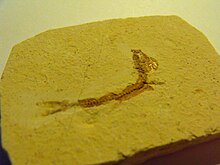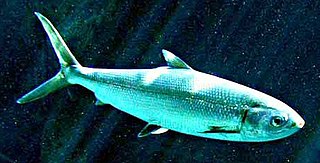
The Gonorynchiformes are an order of ray-finned fish that includes the important food source, the milkfish, and a number of lesser-known types, both marine and freshwater.

The milkfish is the sole living species in the family Chanidae. However, there are at least five extinct genera from the Cretaceous. The repeating scientific name (tautonym) is from Greek khanos.
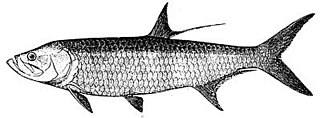
The Elopiformes are the order of ray-finned fish including the tarpons, tenpounders, and ladyfish, as well as a number of extinct types. They have a long fossil record, easily distinguished from other fishes by the presence of an additional set of bones in the throat.
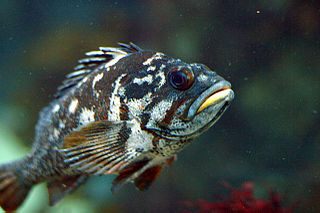
Sebastinae is a subfamily of marine fish belonging to the family Scorpaenidae in the order Scorpaeniformes. Their common names include rockfishes, rock perches, ocean perches, sea perches, thornyheads, scorpionfishes, sea ruffes and rockcods. Despite the latter name, they are not closely related to the cods in the genus Gadus, nor the rock cod, Lotella rhacina.

The Carangidae are a male to female family of ray-finned fish that includes the jacks, pompanos, jack mackerels, runners, trevallies, and scads. It is the largest of the six families included within the order Carangiformes. Some authorities classify it as the only family within that order but molecular and anatomical studies indicate that there is a close relationship between this family and the five former Perciform families which make up the Carangiformes.

Hexagrammidae, the greenlings, is a family of marine ray-finned fishes belonging to the suborder Cottoidei in the order Scorpaeniformes. These fishes are found in the North Pacific Ocean.

Congiopodidae, commonly known as pigfishes, horsefishes and racehorses, is a family of ray-finned fish classified with in the order Scorpaeniformes. These fishes are native to the Southern Hemisphere.

Trichogaster is a genus of gouramis native to South Asia from Pakistan to Myanmar. It is the only genus in the monotypic subfamily Trichogastrinae as set out in the 5th Edition of Fishes of the World, although that book states that there are two genera, the other being Colisa which is treated as a synonym of Trichogaster by Fishbase and the Catalog of Fishes. Fishbase also places the genus in the Luciocephalinae. Species of this genus are very popular in the aquarium trade.
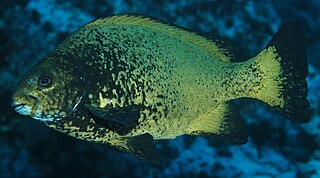
The sea chubs, also known as rudderfish and pilot fish and in Hawaiian as enenue or nenue, are a family, Kyphosidae, of fishes in the order Perciformes native to the Atlantic, Indian and Pacific Oceans usually close to shore in marine waters.

Stichaeidae, the pricklebacks or shannies, are a family of marine ray-finned fishes in the suborder Zoarcoidei of the order Scorpaeniformes. Most species are found in the North Pacific Ocean with a few in the North Atlantic Ocean.

Gymnocephalus is a genus of ray-finned fishes from the family Percidae, which includes the perches, pike-perches and darters. They are from the Western Palearctic area, although one species, Gymnocephalus cernua has been accidentally introduced to the Great Lakes region where it is regarded as an invasive species. They have the common name "ruffe" and resemble the true perches in the genus Perca, but are usually smaller and have a different pattern.

Percarina is a genus of ray-finned fish in the family Percidae found in eastern Europe. The genus is the only taxon in the monotypic subfamily Percarininae, which is characterised by having the first dorsal fin, having 9-11 spines and being widely separated from the second dorsal fin. They are thought to be closely related both to the perches of the genus Perca and to the ruffes of the genus Gymnocephalus.

Lutjanidae, or snappers are a family of perciform fish, mainly marine, but with some members inhabiting estuaries, feeding in fresh water. The family includes about 113 species. Some are important food fish. One of the best known is the red snapper.
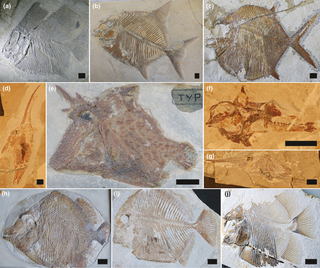
Pycnodontiformes is an extinct order of primarily marine bony fish. The group first appeared during the Late Triassic and disappeared during the Eocene. The group has been found in rock formations in Africa, Asia, Europe, North and South America. They were small to middle-sized fish, generally with laterally-compressed deep bodies, some with almost circular outlines, adapted for manuverability in reef-like environments, though the group was morphologically diverse. Most, but not all members of the groups had jaws with round and flattened teeth, well adapted to crush food items (durophagy), such as echinoderms, crustaceans and molluscs. Some pyncodontiformes developed piranha like teeth used for eating flesh. Most species inhabited shallow marine reef environments, while a handful of species lived in freshwater or brackish conditions. While rare during the Triassic and Early-Middle Jurassic, Pycnodontiformes became abundant and diverse during the Late Jurassic, exhibiting a high but relatively static diversity during the Early Cretaceous. At the beginning of the Late Cretaceous they reached their apex of morphological and species diversity, after which they began to gradually decline, with a more sudden decline at the end of the Cretaceous due to the collapse of reef ecosystems, finally becoming extinct during the Eocene. They are considered to belong to the Neopterygii, but their relationship to other members of that group is uncertain.

Phallostethidae, also known as priapium fish, is a family of atheriniform fish native to freshwater and brackish habitats in southeast Asia.
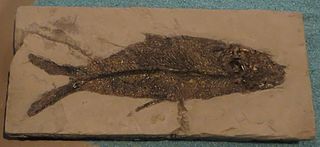
Aethalionopsis is an extinct genus of prehistoric freshwater bony fish from the Early Cretaceous of western Europe. Formerly classified as a species of the elopiform Anaethalion, it is now known to be a relative of the modern milkfish (Chanos) in order Gonorhynchiformes. It was previously placed as a basal member of the suborder Chanoidei, but is now more often placed as a basal member of the subfamily Chaninae of the family Chanidae, placing it closer to the extant Chanos.

Anaethalion is an extinct genus of prehistoric marine and freshwater ray-finned fish related to modern tarpons and ladyfish. It is known from the Late Jurassic to the Early Cretaceous of Europe and northeasterrn Asia, roughly encompassing the Tethys Ocean.
Caeus is an extinct genus of prehistoric marine ray-finned fish, closely related to the modern milkfish. It contains a single species, C. leopoldi from the Early Cretaceous of the Pietraroja Plattenkalk, Italy. It is one of the largest teleosts known from the Pietraroja formation, and is known by only a single specimen.

Plectorhinchinae, is one of two subfamilies of the family Haemulidae, some known colloquially as sweetlips. This subfamily is regarded as having an Old World origin.
Vango is an extinct genus of milkfish from the Late Cretaceous Lac Kinkony Member of the Maevarano Formation of Madagascar. The type species is M. fahiny.

